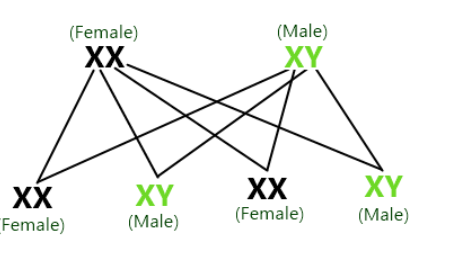
Explain the mechanism of sex-determination in humans.
Answer
493.5k+ views
2 likes
Hint:In humans, 50% of total produced sperm bears X-chromosomes and 50% bears Y-chromosomes which means the offspring has the 50% chance to become male and 50% chance to become female.
Complete answer:
The sex-determining mechanism is a biological system that defines the development of sexual traits in an organism. Many of the species that make up their descendants by sexual reproduction have two sexes. In several animals, sex determination is genetic: females and males have non-identical alleles or even distinct genes that determine their sexual morphology.
In the case of humans, the sex-determining process is XX-XY type. Of the 23 pairs of chromosomes present, 22 pairs are almost the same in both males and females; these are autosomes. A pair of X-chromosomes is found in the female, while the existence of the X-chromosomes and the Y-chromosomes decides the male characteristics. During spermatogenesis between males, two types of gametes are formed. 50 per cent of the total produced sperm bears X-chromosome and the remaining 50 per cent comprises Y-chromosomes in addition to autosomes. Females, though, develop only one type of egg with an X-chromosome. There is an equivalent chance of egg fertilisation of sperm that bears either X or Y chromosome. In the event that the ovum fertilized with the sperm bearing the X-chromosome, the zygote grows into a female (XX) and the fertilisation of the ovum with the Y-chromosome resulting in sperm a male progeny. It is also clear that it is the genetic composition of the sperm that decides the child’s sex.

Fig: Sex determination in human
Note:In humans, the chromosome structure of sex selection is of the XX-XY type. In humans, the nucleus of each cell comprises 46 chromosomes or 23 pairs of body character chromosomes and one pair of sex chromosomes.
Complete answer:
The sex-determining mechanism is a biological system that defines the development of sexual traits in an organism. Many of the species that make up their descendants by sexual reproduction have two sexes. In several animals, sex determination is genetic: females and males have non-identical alleles or even distinct genes that determine their sexual morphology.
In the case of humans, the sex-determining process is XX-XY type. Of the 23 pairs of chromosomes present, 22 pairs are almost the same in both males and females; these are autosomes. A pair of X-chromosomes is found in the female, while the existence of the X-chromosomes and the Y-chromosomes decides the male characteristics. During spermatogenesis between males, two types of gametes are formed. 50 per cent of the total produced sperm bears X-chromosome and the remaining 50 per cent comprises Y-chromosomes in addition to autosomes. Females, though, develop only one type of egg with an X-chromosome. There is an equivalent chance of egg fertilisation of sperm that bears either X or Y chromosome. In the event that the ovum fertilized with the sperm bearing the X-chromosome, the zygote grows into a female (XX) and the fertilisation of the ovum with the Y-chromosome resulting in sperm a male progeny. It is also clear that it is the genetic composition of the sperm that decides the child’s sex.

Fig: Sex determination in human
Note:In humans, the chromosome structure of sex selection is of the XX-XY type. In humans, the nucleus of each cell comprises 46 chromosomes or 23 pairs of body character chromosomes and one pair of sex chromosomes.
Recently Updated Pages
Master Class 9 General Knowledge: Engaging Questions & Answers for Success

Master Class 9 English: Engaging Questions & Answers for Success

Master Class 9 Science: Engaging Questions & Answers for Success

Master Class 9 Social Science: Engaging Questions & Answers for Success

Master Class 9 Maths: Engaging Questions & Answers for Success

Class 9 Question and Answer - Your Ultimate Solutions Guide

Trending doubts
Give 10 examples of unisexual and bisexual flowers

Draw a labelled sketch of the human eye class 12 physics CBSE

Differentiate between homogeneous and heterogeneous class 12 chemistry CBSE

Differentiate between insitu conservation and exsitu class 12 biology CBSE

What are the major means of transport Explain each class 12 social science CBSE

Why is the cell called the structural and functional class 12 biology CBSE




